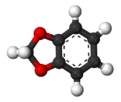1,3-Benzodioxole
From Wikipedia, the free encyclopedia
| 1,3-Benzodioxole | |
|---|---|
 |
 |
| Identifiers | |
| CAS number | 274-09-9 |
| PubChem | 9229 |
| ChemSpider | 13881169 |
| EC number | 205-992-0 |
| UN number | 1993 |
| MeSH | 1,3-Benzodioxole |
| ChEBI | CHEBI:38732 |
| RTECS number | DA5600000 |
| Beilstein Reference | 115506 |
| Jmol-3D images | Image 1 Image 2 |
| |
| |
| Properties | |
| Molecular formula | C7H6O2 |
| Molar mass | 122.12 g mol−1 |
| Density | 1.064 g cm-3 |
| Boiling point | 173 °C; 343 °F; 446 K |
| log P | 2.08 |
| Vapor pressure | 1.6 kPa |
| Thermochemistry | |
| Std enthalpy of combustion ΔcH |
-3.428 MJ mol-1 |
| Hazards | |
| GHS pictograms |  |
| GHS signal word | WARNING |
| GHS hazard statements | H302, H332 |
| EU classification | |
| R-phrases | R20/22 |
| S-phrases | S22, S24/25 |
| NFPA 704 |
 2
1
0
|
| Flash point | 61 °C; 142 °F; 334 K |
| Except where noted otherwise, data are given for materials in their standard state (at 25 °C (77 °F), 100 kPa) | |
| Infobox references | |
1,3-Benzodioxole, 1,2-Methylenedioxybenzene is an aromatic ring and a heterocyclic compound containing the methylenedioxy functional group. 1,3-Benzodioxole is synthesized from catechol with disubstituted halomethanes.[1][2] 1,3-Benzodioxole is useful in gemological stimulant detection. It is precursor for perfumes, insecticides, and pharmaceuticals.
See also
References
- ↑ Bonthrone, W. and Cornforth, J. (1969). "The methylenation of catechols". Journal of the Chemical Society: 1202–1204. doi:10.1039/J39690001202. Retrieved 28 December 2013.
- ↑ Fujita, Harushige and Yamashita, Masataro (1973). "The Methylenation of Several Allylbenzene-1,2-diol Derivatives in Aprotic Polar Solvents". Bulletin of the Chemical Society of Japan 46 (11): 3553–3554. doi:10.1246/bcsj.46.3553. Retrieved 27 December 2013.
This article is issued from Wikipedia. The text is available under the Creative Commons Attribution/Share Alike; additional terms may apply for the media files.